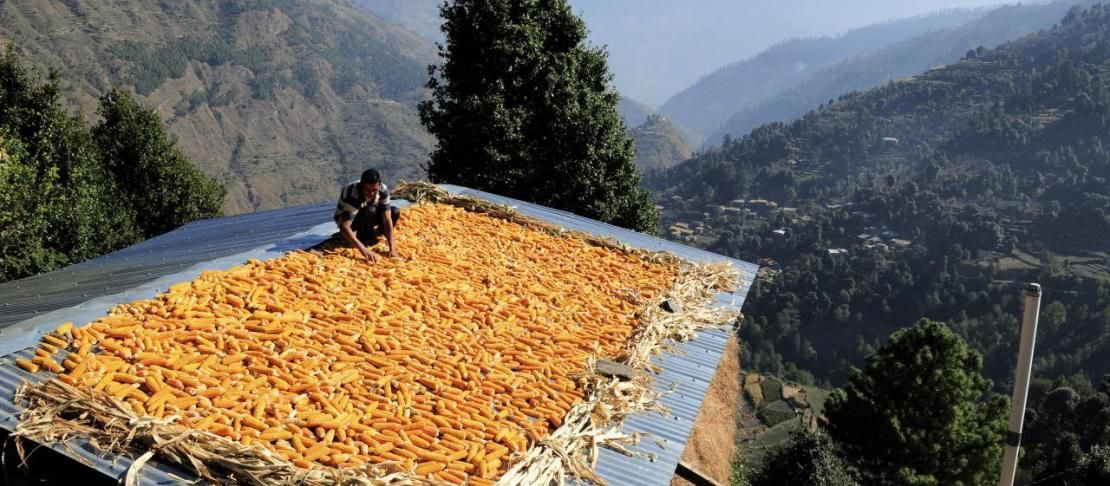Tending to the crying earth and the weeping shores

In celebration of World Environment Day, we summarize our efforts to build resilience in one of the most fundamental of all human activities, agriculture
It was in 1972 that World Environment Day campaign was established by the United Nations General Assembly as a way of shedding light on environmental issues. Twenty-three years later, Michael Jackson sang, “did you ever stop to notice, all the blood we’ve shed before, did you ever stop to notice, this crying earth, these weeping shores”. This is not to say that the artist’s ode to the planet stemmed directly from the campaign, but that by then, the world’s attention was increasingly being drawn to earth’s torment due to anthropogenic activities.
One of the most significant impacts brought about by anthropogenic activities is global warming, and this change in the climatic condition threatens nearly all aspects of life on earth. One anthropogenic activity fundamental to human life, which stands to play a critical role in the management of our changing climate, is agriculture: the sector contributes at least one-fifth of total greenhouse gas (GHG) emissions through crop production, livestock, and the conversion of forests into farmlands.
Agriculture and food security under a changing climate
But agriculture is on both sides of the climate narrative, as a victim and perpetrator, presenting unique challenges for mitigation, adaptation, and food security. Extreme weather events attributable to climate change are affecting agricultural productivity, livelihoods, and infrastructure at alarming levels. This is especially true in the case of the tropics, which host some of the world’s poorest nations. Populations in these areas are projected to suffer the most on account of food price volatility due to production shortages brought about by climate change.
Among the most vulnerable people are the smallholder farmers, particularly in the developing countries of Africa and South Asia. The challenges posed by climate change affect many aspects of life: for instance, climate-induced outmigration from rural areas to urban ones can lead to a wide range of complex issues like urban poverty, the feminization of agriculture, and socio-economic and psychological vulnerability.
Climate-smart agriculture: a beacon of hope
Given that millions of smallholder farmers depend on activities that are intricately tied to the climate, adaptation and mitigation efforts support to them are crucial for development. The CGIAR Research Program on Climate Change, Agriculture and Food Security (CCAFS), along with its partners, has been working in five regions of the world to develop transformative solutions to help smallholders cope with the impacts of climate change.
Among these are climate-smart agricultural (CSA) technologies and practices. As an approach, CSA advocates the use of sustainable and improved agronomic practices that can make agricultural production resilient while reducing GHG emissions. Proven CSA practices include integrated nutrient management, improved and resilient seed varieties, crop diversification, agroforestry, livestock improvement, efficient water management and conservation tillage, among others. These are often used in conjunction with crop insurance and ICT-delivered agro-advisory services, which help farmers to make informed choices. Advanced technologies, such as remote sensing and GIS-based applications, can help to construct more precise solutions for agriculture. CSA is not only locally contextualized but also helps to reduce overall agrarian distress by focusing on building the capacities of farmers through activities like training, participatory varietal evaluations, farmer-to-farmer learning exchanges, and others.
Unfurling CSA through Climate-Smart Villages in India
India, which is hosting World Environment Day this year, is unique in that it comprises 21 different agro-ecological regions. However, its mostly rain-fed agriculture is suffering on account of the changing climate, which has led to erratic and unpredictable rainfall, floods, droughts, cyclones, and heat waves, which are projected to increase in the future.
To bring about a transformation in agriculture in India, CCAFS has initiated, apart from a range of other interventions, the Climate-Smart Village (CSV) approach. Since its inception in 2012, this approach has been scaled up to numerous locations within India, to the neighbouring countries of Nepal and Bangladesh, and to 20 other countries across East and West Africa, Southeast Asia and Latin America.
CSVs are village clusters that are chosen as sites for testing CSA technologies and practices through participatory methods. They are the real life participatory test beds for generating evidence on which CSA technologies and practices work and which do not in a given setting, laying the roadmap for scaling by farmers, development practitioners and policymakers.

Types of climate-smart options that may be tested as part of context-specific portfolios in the CSV sites.
Starting from the North Indian states of Haryana and Punjab, the CSVs have now percolated to other locations in India, including Rajasthan, Uttar Pradesh, Bihar, Madhya Pradesh, Maharashtra, Gujarat and Telangana. New partnerships have been formed with both the private sector and development agencies like USAID to scale this approach in formerly isolated tribal areas of India, such as Betul in Madhya Pradesh. With the Haryana state lending its support to scaling out 500 CSVs, the road ahead looks encouraging.
Speaking on the occasion of World Environment Day, Dr. Pramod Aggarwal, Regional Program Leader of CCAFS South Asia, said, “It is a duty of science and those who practice it to apply its principles for social action. Efforts to help a stressed planet while uplifting communities is one of the pillars of the CSV approach”. CSA, proliferated through the CSV approach, stands to provide millions with a beacon of hope.
Read more:
- Journal paper: The climate-smart village approach:framework of an integrative strategy for scaling up adaptation options in agriculture
- Brochure: South Asia Climate-Smart Villages ARD4 Sites
Shehnab Sahin is the Communicaions Specialist at CCAFS South Asia



